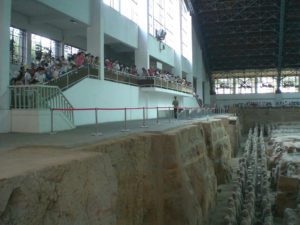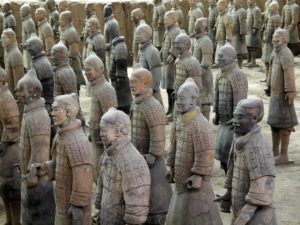Top 10 Facts About The Terracotta Army
The Terracotta Army isn’t your typical army complete with weapons marching into war. It is a collection of terracotta- ceramic or earthenware sculptures- similar to the actual armies of the first Emperor of China, Qin Shi Huang. They are said to have been buried with the emperor for his protection in the afterlife.
The Terracotta Army was discovered by farmers drilling a well- they discovered a subterranean chamber that archaeologists examined and found to contain clay models of soldiers, horses, and chariots which were deposited around the grand mausoleum. Here are the top 10 facts about the fascinating Terracotta Army.
1. The Terracotta Army is described as the eighth wonder of the world
Former French President, Jacques Chirac said of the Terracotta Army as a must-see- you cannot have really visited China if you didn’t see the Terracotta Army. The Former president hailed the Army as the eighth wonder of the world.
2. The Terracotta Army is at least 2,200 years old!
The level of skill and craftsmanship displayed in the making of the Terracotta army is extraordinary, especially with the knowledge that there weren’t any sophisticated equipment to make them.
The army has also lasted more than 2,200 years, with most of its intricate details intact. To this day, the soldiers are still standing.
3. Constructing the Terracotta soldiers required massive manpower
The Terracotta Army took about 40 years to complete; the work was done by over 700,000 laborers, most of whom were imperial craftsmen and folk craftsmen.
Construction began in 246 BC and ended in 206BC, four years after Emperor Qin had died.
The laborers worked around the clock to complete the army and tomb complex in which they stand.
4. The Terracotta Army figures are distinct
Despite the large number of the Terracotta Army figures, none of them is ‘copy-paste’. The detail on their faces and delicate craftsmanship makes each one of them unique. The warriors have exclusive facial features. Among the figures you will find the infantry, archers, generals and cavalry, all different in their expressions, clothing and hairstyles.
The parts of the warriors were separately created then assembled. Each Terracotta warrior had their body stamped with the name of the foreman that created it so as to track for mistakes. The Terracotta Army creation was taken pretty seriously.
5. Droves of tourists visit the Terracotta Army
The Terracotta Army always has an audience! Visitors come for a glimpse of the eighth wonder of the world such that the place is always crowded with residents and international visitors, particularly so on weekends and public holidays.
In 2015 alone, over five million tourists visited.
The compound holding the Terracotta Army was declared a UNESCO World Heritage site in 1987. It would be a disservice not to ensure that the figures live on and the rich history is preserved.
6. The Terracotta Army has not been unearthed in totality
There are more terracotta figures yet to be uncovered. Go figure!
Three out of the four pits have been unearthed, leaving one whose excavation is not complete. As you can imagine, the excavation is a delicate process if the work is to be unearthed in its completeness with little or no damage. To put the delicateness in perspective, some of the painted surfaces of some terracotta figures began to flake and fade after excavation- the lacquer covering the paint on the figures can curl within no time once exposed to dry air.
Apart from the manual labor while excavating and being extremely cautious about it, there has to be research around how best to approach the task as well as ensure limited to no damage once exposed.
Excavations on the site carried on into the 21st century. Archaeologists anticipated that it would take years to unearth the entire tomb complex.
7. The Terracotta Army had other figures buried with it
While the Terracotta Army figures are many, almost to an overwhelming point at least 8,000 soldiers, there are other items that are part of the collection. It features bronze chariots and carriages. At least 130 chariots and 670 horses have been unearthed.
Along with the Army, Terracotta musicians, acrobats, and concubines were found in recent pits as well as some birds, such as waterfowl, cranes, and ducks. Quite the finishing touches in preparation of the afterlife by Emperor Qin!
8. The Terracotta Army’s King is yet to be unearthed
Emperor Qin’s tomb is yet to be opened, and this is the greatest mystery! For an Emperor keen on enjoying and having an afterlife that at least met the standards he was accustomed to on earth, there is no telling what will be found in his tomb. The Terracotta Army was made for service to Emperor Qin.
9. The Terracotta Army is being preserved
It would be a shame for such amazing archeological finds to be ruined upon discovery after staying unscathed for centuries. While the Army was discovered in a pretty good state, it has had to be repaired and restored, then further preserved.
For instance, Scientists are using various techniques to preserve the vibrant paints on the warriors- their faces, hands and feet are all pink and their faces feature white -eye corners and black eyes. Their hair, beard and eyebrows are black. As they get excavated, these details are treated for preservation.
10. The Terracotta Army was a brigade
Experts estimate there are more than 8,000 soldiers, 130 chariots, and 670 horses. The warriors are mostly armed with bronze weapons that include bows, gongs, arrows, gongs, spears, gems, swords, swords, machetes, and gongs. The warriors also wear armored armor.
The Terracotta Army was clearly a garrison for the Emperor.
Emperor Qin Shi Huang spent much of his life searching for immortality. Construction of his tomb began when he was only 13 years old, as soon as he assumed the throne. It is said that he died of poisoning after ingesting mercury pills believing that it would give him immortality.
The concept of death and the afterlife is quite fascinating and such a paradox. Now that the Terracotta Army was unearthed, what does that mean for Emperor Qin Shi Huang’s afterlife?
The Terracotta Army features in popular culture with movies, as depicted in the movie “The Mummy” and “Furious Seven”. They are a sight to behold, and such a great display of China’s advancement even hundreds of years ago.
Planning a trip to Paris ? Get ready !
These are Amazon’s best-selling travel products that you may need for coming to Paris.
Bookstore
- The best travel book : Rick Steves – Paris 2023 – Learn more here
- Fodor’s Paris 2024 – Learn more here
Travel Gear
- Venture Pal Lightweight Backpack – Learn more here
- Samsonite Winfield 2 28″ Luggage – Learn more here
- Swig Savvy’s Stainless Steel Insulated Water Bottle – Learn more here
Check Amazon’s best-seller list for the most popular travel accessories. We sometimes read this list just to find out what new travel products people are buying.

















